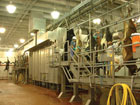
Hide-on wash significantly reduces microbial load. Source: Cargill.
Major food processors, retailers and national consumer organizations convened in Washington, DC for an all-day symposium focused on food safety innovation and best practices. The first-of-its-kind symposium was sponsored by Cooperating for Food Safety (CFS), a new non-profit, consumer-led organization whose mission is to reduce food-borne illness by fostering continued development and wider adoption of state-of-the-art food safety best practices.
Nancy Donley, president of Safe Tables Our Priority and CFS board chair, commended industry leaders, government regulators and consumers for joining forces to fight E. coli and other food-borne illnesses. Donley lost her six-year-old son to E. coli O157:H7 in 1993. Danny Wegman, chairman and CEO of Wegmans Food Markets, presented a retail perspective of food-borne illnesses and spoke of Wegmans’ use of irradiation on ground beef.
Setting the stage for sharing information, Bill Buckner, corporate vice president, Cargill, presented five steps developed over several years, “multiple hurdles,” in the post-slaughter processing of beef cattle to reduce pathogen levels. These steps include hide-on wash (where E. coli tends to exist in large numbers), steam vacuum (after hide is removed), pre-evisceration organic acid rinse, post-evisceration carcass wash and steam pasteurization (180